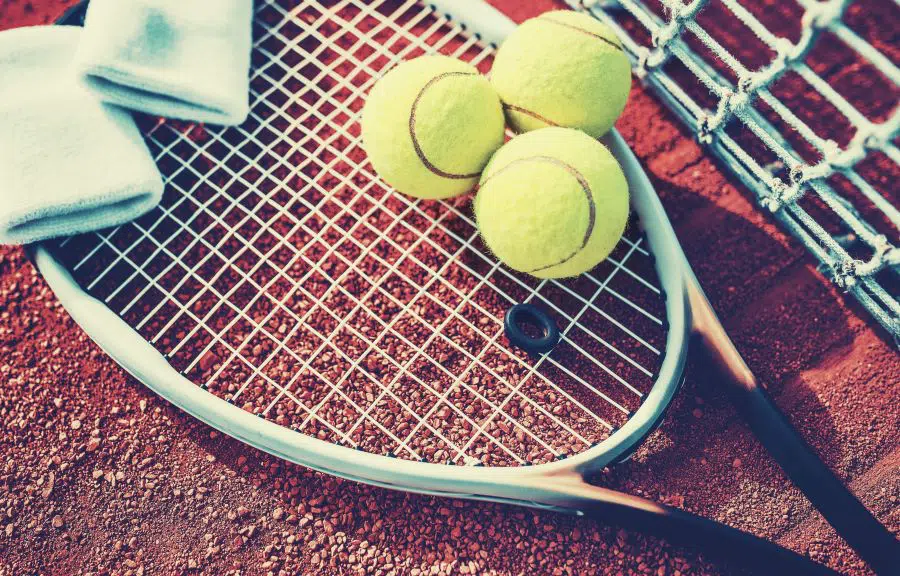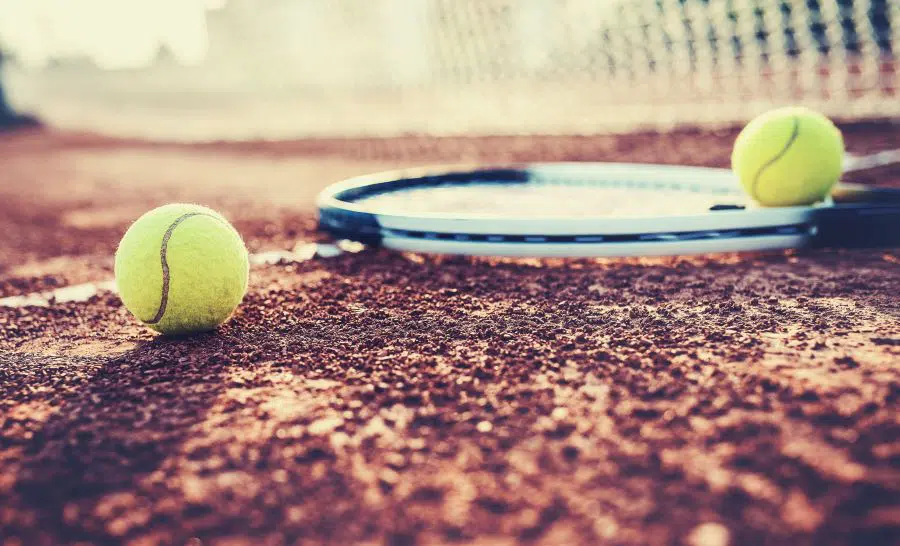Vibration dampeners are the small pieces of rubber you often see attached to a tennis racket. You may well have seen them and thought what do they actually do? Are they used by pro tennis players, and if so do they offer any real advantages?
Many of the world’s top pro tennis players use a vibration dampener. Nearly 60% of the top men and around 75% of the top women tennis players prefer to use vibration dampeners.
This article will look at why players use vibration dampeners. It will also take a look at some of the pro tennis players who use them, and also some of the notable exceptions who do not.

What Are Vibration Dampeners?
As the name suggests, vibration dampeners are designed to reduce the vibration felt when striking a tennis ball. They were first introduced by Rene Lacoste in 1964 and were originally aimed at preventing injury.
As mini shock absorbers, it was thought they could reduce the stress on the arm and wrist, preventing tennis elbow and other injuries.
However, studies over the years suggest there is no evidence vibration dampeners reduce the risk of injury, including tennis elbow (source). While they reduce vibration on the strings, these small pieces of rubber do not reduce the vibration felt through the frame of the racket (source).
If the prime reason for which they were originally developed is not proven then you may wonder why you would continue using a vibration dampener?
The Reasons Players Use a Vibration Dampener
Despite the evidence, the notion that vibration dampeners reduce injury still persists in some quarters. However, for most players who use vibration dampeners, it is now more about the sound.
Put simply, a vibration dampener can reduce the ‘ping’ sound as the ball strikes the racket, a sound that many players find annoying and distracting.
As the dampener reduces the vibration on the racket strings it also reduces the sound made by the strings when striking the ball. If you have never used a dampener the sound the racket makes might not register so much.
However, once you have used a vibration dampener the increased volume when striking the ball can be very obvious.
There are players who are adamant that sound alone is not the sole reason why vibration dampeners help them play better. Some players say a dampener affects the feel of the racket as you strike the ball.
The racket can feel softer using a dampener, or the racket feels different depending on whether the dampener is in place or not.
A preference for using a dampener may be more about the mental approach to the game than a physical one.
The last thing a player needs is to be anticipating how loud the next shot will sound or whether the feel of the racket is off. They need to have complete confidence in their racket. When playing at the top level the concentration has to be total without any unnecessary distractions.
Which Pro Tennis Players Use a Vibration Dampener?
The number of professional players using vibration dampeners would clearly suggest some of the world’s best players see any advantage in using them.
When you look through the top 20 of both the men’s and women’s game, around 60-80% employ dampeners on their rackets.
On the men’s side of the game players that have vibration dampeners on their strings include:
- Novak Djokovic
- Rafael Nadal
- Daniil Medvedev
- Alexander Zverev
- Gael Monfils
- Stan Wawrinka
For the women’s game, there is an equally impressive list of proponents of vibration dampeners, including:
- Ashleigh Barty
- Simona Halep
- Naomi Osaka
- Petra Kvitova
- Victoria Azarenka
- Garbine Muguruza
These are just a sample of what is quite a lengthy list of the game’s top-ranking players currently using vibration dampeners.
Therefore, whether their use improves a player’s mental approach through increased confidence in the racket or not, far too many top players see benefits in using vibration dampeners to overlook their potential.
Are There Different Types of Vibration Dampeners?
Yes, there are two main types of dampeners – button and worm.
The button style is the one most commonly used by pro players like Novak Djokovic. This type of dampener is small, button-shaped, and easy to apply to the racket, attaching to just a couple of strings.
Their easy installation makes them a favorite among many of the top pro players, as they can be quickly replaced during a match.
The fact that the button-type dampeners are quick to install is also paradoxically one of their weaknesses, as they are more likely to fly off the racket following a mishit.
Therefore, to save scrambling around looking for them on the court, you will need to ensure you have a few spares in your bag.
The alternative is to use a worm-type vibration dampener. These styles of dampeners are longer and can attach to ten strings. They are more fiddly to install as they need to be weaved in between the strings. On the plus side, once they are installed they are less likely to fall out.
These style of dampeners can feel heavier on the racket, but should more strongly absorb the string vibrations.

Can I Place Vibration Dampeners Anywhere on a Racket?
No, vibration dampeners must be positioned outside of the pattern of the crossed strings on a tennis racket. This is a stipulation within the rules of the game.
Therefore, in theory, there are four sections of the racket where they can be placed. This is at the top, bottom, or on outer sections of the racket.
In practice, the majority of players install vibration dampeners across the middle strings in the lower section of the racket.
This is a location that minimizes the risk of contact between the ball and the rubber dampener. Installing a dampener can take a little getting used to initially, particularly the worm variety, but with a little practice, they should become easy to apply.
The following video explains how to legally position a vibration dampener:
Pro Tennis Players Who Prefer Not to Use Vibration Dampeners
There are a few notable players who opt not to use vibration dampeners, including Roger Federer and Serena Williams. Federer used to use a dampener but decided to dispense with them even though the additional noise levels annoyed him for a while.
A Federer racket is not completely unadorned as he uses power pads. Power pads are leather strips that separate the strings from the outer part of the grommet, the nylon or plastic which protects the string holes on the racket.
Power pads were seen more in the days of wooden tennis rackets, which had sharper-edged grommets. While they do not reduce the ‘ping’ sound from the strings, they do have the effect of dampening down the feel similar to a vibration dampener.
Andre Agassi would use his own DIY vibration dampeners in the form of rubber bands.
It is said he first used rubber bands as this was all he could afford when coming through the ranks of the game.
Rubber bands have the further advantages of allowing you to shape them how you want, as well as being unlikely to break. In Agassi’s case, they just looked cool too!
Other pro tennis players who do not use vibration dampeners include:
- Andy Murray
- Dominic Thiem
- Karolina Pliskova
- Johanna Konta
Conclusion
Many pro tennis players use vibration dampeners, feeling the rubber accessories benefit their game. Research has disproved the initial hope that they would reduce injuries within the sport.
The main point to remember is vibration dampeners reduce vibrations in the strings, but not the frame.
There is a fairly even split on the men’s side between the top professionals who use dampeners and those who do not. In the women’s game around three-quarters of the top players opt to use dampeners.
Most rackets have a built-in dampening design these days, suggesting the main reason players prefer to use a dampener is to reduce the volume of the ’ping’.
